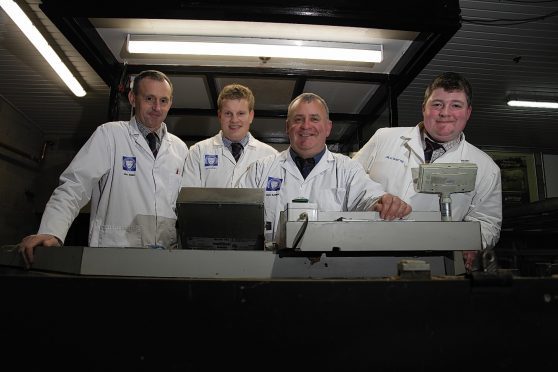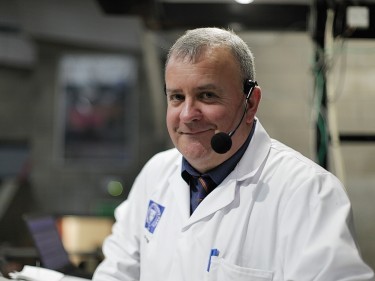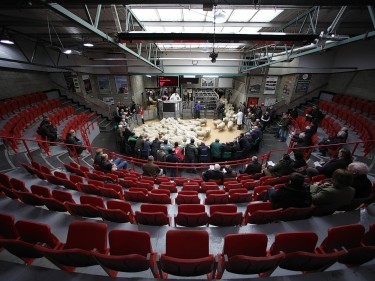Despite having what he laughingly describes as “the perfect face for radio” auctioneer Colin Slessor is about to become a familiar face on TV, but the real star of the new show is the place where he works – the mart at Thainstone Centre, Inverurie.
The mart is one of the biggest markets of its kind in Europe, and the largest farmer-owned livestock company in Europe with annual sales exceeding £90million. It handles more than 100,000 store, prime and breeding cattle and more than 500,000 store, prime and breeding sheep at its two purpose-built auction centres in the north and north-east.
The mart draws farmers and their stock from across Scotland, while buyers come from all corners of the country and on main auction days it’s buzzing and lively. The main market day at the Thainstone Centre is a Friday with weekly sales of store and breeding cattle and sheep while Thursday is dedicated to selling prime stock.
The mart is where deals can run into megabucks and livelihoods can hang in the balance. As narrator of The Mart, Denis Lawson, says in the first episode: “Farming is a risky business and when it’s time to make money the stakes are high.” Having primed and preened their beasts to look their absolute best, farmers are on tenterhooks as their animals enter the auction ring.
The onus is on auctioneers such as Aberdeen and Northern Marts sheep sales manager Colin Slessor, 47, to get the best price they can. “I was brought up on a Buchan farm as a laddie and was a shepherd from the age of 17. After eight years I applied to become a trainee auctioneer to try and further myself a wee bit and got a job here,” said Colin. “I have sold furniture, antiques and cars but my heart is in livestock and, in particular, sheep.”
What the programme shows clearly is that the auctioneers, and all the staff working at the mart, have the farmers best interests at heart.
“That’s very much the case because it’s the farmers livelihood, not just another sale,” said Colin. “These guys are depending on the income they get from the auction and when you’re selling a hundred or more sheep, even a couple of pounds extra per head of sheep can make a difference to them.”
As the cattle and sheep parade around the ring, the serious business of selling gets under way. Spotting who wants to place a bid can be a tricky business for anyone other than a trained auctioneer.
“Some people will wave a catalogue or hand making their intention very clear while others don’t, they have a certain style of bidding such as raising an eyebrow – you get used to it,” said Colin who once sold a single sheep at auction for a whopping £4,000.
“The livestock prices have crept up over the last 22 years but that’s levelled off of late and the prices are a wee bit less than they were a couple of years ago. You do get a buzz when you step up to the rostrum but that’s because you have a will to do the best you can.
“If you do get a good sale, when something has sold for more than expected, you can take a minute or two to come down from that whereas if things are cheaper than expected you can get a wee bit despondent so you have to learn to deal with the highs and lows. At the end of the day you still have to go home at night and be cheery.”
At Thainstone there are around 10 who look after the auctioneering side of things and while they have a high profile, Colin says it’s the backroom staff who work at the mart which has three purpose-built sale-rings, a large exhibition hall, covered accommodation for 3,000 cattle or 14,000 sheep (or a combination of both) and straw-bedded lairage accommodation, who are the real stars.
“We have excellent office and yard staff and they are fundamental to what we do. Without the guys physically handling the livestock by taking them off the lorries and putting them into the pens, and the office staff doing the paperwork, we couldn’t do our job.”
Thainstone is widely recognised as the most modern auction mart in Europe as a result of its innovative design features and excellent livestock-handling facilities which ensure the efficient and stress-free handling of stock. But as the show reveals, handling animals can be a pretty intensive job.
Sheep are seen excitedly jumping all over the place while the cattle can be excitable and skittish, something that’s possibly due to hi-tech farming methods which means they are less likely to be in contact with humans, and therefore more nervous of them, than cattle reared using older farming methods.
“The cattle can be a wee bit wild at times so they have to be very careful but our guys are very experienced at handling them. A lot of them work part-time but they do long hours, stick in and don’t moan about the job which doesn’t suit everyone. Without them we are nothing,” said Colin.
The new six-part observational documentary series from BBC Scotland, which is screened from Monday at 7.30pm on BBC Scotland, also reveals there’s more to the auctioneers than slamming the gavel on the rostrum. “Part and parcel of what we do is called canvassing when we go out and visit the farmers before a sale to perhaps assist the farmer with the selection of stock. It’s a great part of the job going out to meet the farmers – there’s nobody better.
“The folk we work with and our customers are the salt of the earth and hard-working guys and that makes this a pleasurable job,” said Colin who had a brush with cancer seven years ago.
“I had a mixed-type tumour, lost all my hair and three stone in weight. It was a scary time, especially with having a wife and two young kids, but after 15 weeks of chemo and an operation everything was fine. I feel very fortunate and have no complaints about life,” said Colin who was part of the mart team which helped raise a massive £80,000 for cancer research charities during its 25th anniversary year.
“I think the TV series will be a bit of an eye-opener for those who have never been on a farm or are unfamiliar with farming life. Hopefully the public will find it informative, funny and interesting.”


